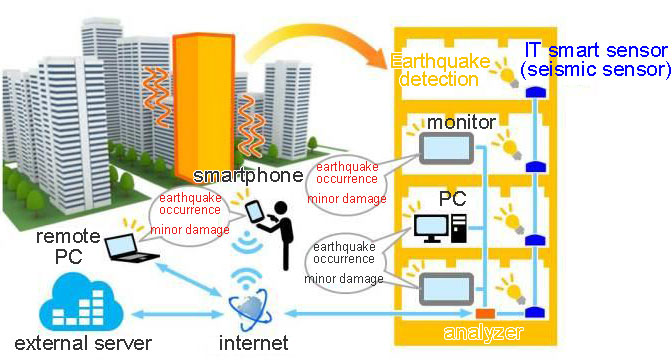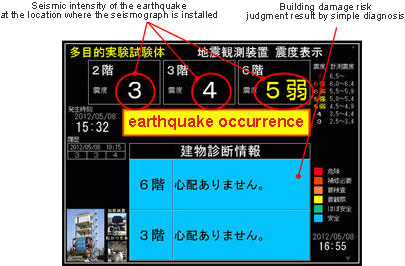Overview
 The Building Medical System is an easy-to-understand system that provides diagnostic results on the integrity of buildings a few minutes after an earthquake, when the building is subjected to severe shaking due to an earthquake. After the shake is eliminated, the results of the audit can be checked without waiting for an expert's diagnosis, helping to determine whether you can stay in the building or not.
The Building Medical System is an easy-to-understand system that provides diagnostic results on the integrity of buildings a few minutes after an earthquake, when the building is subjected to severe shaking due to an earthquake. After the shake is eliminated, the results of the audit can be checked without waiting for an expert's diagnosis, helping to determine whether you can stay in the building or not.In recent years, there have been concerns about the occurrence of massive earthquakes, and we have been introducing this system mainly in high-rise office buildings and condominiums.
Advantages
You can know the degree of damage to the building in real time. It is effective as a BCP support tool.Features
System Overview
The IT Smart Sensor detects earthquake motions, and the analyzer analyzes the data, makes immediate soundness judgments, and distributes the results of the diagnosis. This makes it possible to calm down the initial response after a large earthquake.Determine the degree of damage in real time

Display image when an earthquake occurs
Based on the observed magnitude of the building shake and the magnitude of the earthquake ground motion acting on the building, the Simple Diagnostic Server immediately determines the degree of damage to the building. The result of the judgment is output to the monitor, etc. in real time.
As countermeasures support tool for people having difficulty returning to home, BCP and LCP
Seismic intensity differs greatly between the ground floors and mid-/high-rise floors in high-rise buildings. Therefore, (1) the JMA seismic intensity scale equivalent of the representative floor, (2) the sway width of each floor, and (3) the results of the diagnosis of the structural frame are displayed in an easy-to-understand diagram. This will also make it effective for measures accepting people who are difficult to go home based on the Tokyo Metropolitan Government's ordinance on measures for people who have difficulty returning to home.It will be used as a support tool for BCPs and LCP for public facilities and hospitals, which will be a key base for disaster recovery, as well as for manufacturing facilities and skyscrapers, which have a major impact on business and living after the earthquake. For example, immediate mail delivery to mobile terminals is also possible, which helps you to quickly identify damage conditions at production facilities located far away and establish an initial system.